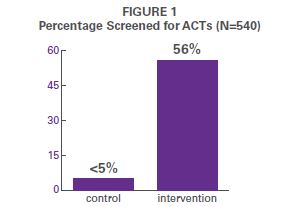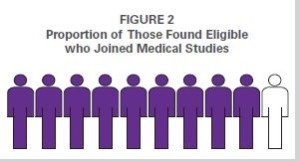- Not enough people of color enroll into ACTs, particularly African-Americans/Blacks and, to a lesser extent, Latinos/Hispanics.
- These groups face many complicated barriers to enrolling in ACTs.
- We evaluated how well a peer-driven intervention (PDI) worked to increase rates of screening for and enrollment into ACTs for these groups.
- Participants were 540 adult African-American/Black and Latino/Hispanic persons living with HIV/AIDS in New York City, recruited through peers.
- Most participants had been living with HIV/AIDS for over 10 years but very few had been given access to ACTs.
- The study compared how well the intervention worked compared to a typical health education program.
- Intervention elements included small group sessions, the opportunity to educate 3 peers about ACTs, and “navigation,” that is, support from others through the screening, eligibility, and enrollment process.
- ACT2 was specifically designed for African-Americans/Blacks and Latinos/Hispanics.
 Participants in the intervention group were >30 times more likely to go through the screening and eligibility process for ACTs than those who did not receive the ACT2 intervention.
Participants in the intervention group were >30 times more likely to go through the screening and eligibility process for ACTs than those who did not receive the ACT2 intervention.
- About 1/2 of those who went through the screening process were found eligible for studies (48.6%). Almost all of those found eligible for a study joined the study, resulting in a total of 44.4% of those screened deciding to join a study.
 That means 9 out of 10 of those found eligible for a medical study joined a study.
That means 9 out of 10 of those found eligible for a medical study joined a study.
- ACTs included studies of new treatments, and also studies where people participated in medical testing or gave blood or tissue samples but did not receive treatments (called “observational” studies).
- It was much easier to involve participants in observational studies than studies of new treatments.
An intervention called the ACT2 Project greatly increased the numbers of African-American and Latino/Hispanic persons living with HIV/AIDS who entered research studies of treatments for HIV/AIDS (called AIDS clinical trials) and other similar medical studies.
Sites providing HIV care and services, or units that conduct trials, can put this approach into place so that more African-American and Latino/Hispanic individuals with HIV/AIDS can gain access to these important medical research studies.
Gwadz M, Leonard NR, Cleland CM, Riedel M, Banfield A, Mildvan D, & the ACT2 Project Collaborative Research Team (2011). The effect of peer-driven intervention on rates of screening for AIDS clinical trials among African Americans and Hispanics. American Journal of Public Health, v101, 1096-1102.
Gwadz, M., Cleland, C.M., Leonard, N.R., Ritchie, A.S., Banfield, A., Riedel, M., Colon, P., & Mildvan, D. (2012). Predictors of screening for AIDS clinical trials among African Americans and Latino/Hispanics enrolled in an efficacious peer-driven intervention: Uncovering socio-demographic, health, and substance use-related factors that promote or impede screening. AIDS and Behavior. Advance online publication. doi: 10.1007/s10461-012-0194-1
Or contact Marya Gwadz, PhD at marya.gwadz@nyu.edu
Supported by a grant from the National Institute of Allergy and Infectious Diseases (R01AI070005).
